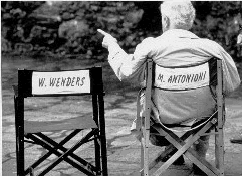
 Michelangelo
Antonioni (1912- ), Italian avant-garde motion-picture director
and screenwriter, whose films are known for their haunting images
of human isolation. Born in Ferrara, Antonioni entered the film
industry in 1942 as a screenwriter and later became an assistant
director. Antonioni's first feature film was STORY OF A LOVE (1950).
Antonioni's best-known films are his trilogy THE ADVENTURE (1960),
NIGHT (1961), and ECLIPSE (1962); RED DESERT (1964), his first color
film; BLOWUP (1966), his first English-language film; ZABRISKIE
POINT (1970); and THE PASSENGER (1975). Later he directed IDENTIFICATION
OF A WOMAN (1982) and BEYOND THE CLOUDS (1995). Michelangelo
Antonioni (1912- ), Italian avant-garde motion-picture director
and screenwriter, whose films are known for their haunting images
of human isolation. Born in Ferrara, Antonioni entered the film
industry in 1942 as a screenwriter and later became an assistant
director. Antonioni's first feature film was STORY OF A LOVE (1950).
Antonioni's best-known films are his trilogy THE ADVENTURE (1960),
NIGHT (1961), and ECLIPSE (1962); RED DESERT (1964), his first color
film; BLOWUP (1966), his first English-language film; ZABRISKIE
POINT (1970); and THE PASSENGER (1975). Later he directed IDENTIFICATION
OF A WOMAN (1982) and BEYOND THE CLOUDS (1995). Antonioni is known for a unique cinematographic style that employs lengthy tracking shots of human figures against a barren natural landscape or a scene of urban sterility. Antonioni wrote or cowrote the screenplays of most of his films. In 1994 he received a special Academy Award for his achievement in film. (Source: Microsoft¨ Encarta¨ Online Encyclopedia 2000 © 1997-2000 Microsoft Corporation. All rights reserved.) |
|||
| Carlo
di Carlo and Giorgio Tinazzi's THE ARCHITECTURE OF VISION: WRITINGS
AND INTERVIEWS ON CINEMA is wonderfully inspiring. In it, Antonioni
says "I don't believe that what an author says about himself... would
help make sense of his work." The collection of writings however are
undeniably treasures, with insights into a vision and an understanding
of life that manifests itself through moving images set against a
minimalist's canvas. Like catching someone's smile, acknowledging
a simple truth, watching a film like ULYSSES' GAZE or Antonioni's
RED DESERT, these essays bring the mind home to the point beyond knowledge,
beyond phenomena, back to the still point as T.S. Eliot would say.
"Making a Film Is My Way of Life" - From Cinema nuovo 138, March-April 1959. Originally translated in Film Culture 24, Spring 1962. "I think filmmakers should always try to reflect the times in which they live; not so much to express and interpret events in their most direct and tragic form...but rather to capture their effect upon us, and to be sincere and conscientious with ourselves, to be honest and courageous with others. In my opinion, it is a singular way of living. What is it that torments and motivates modern man? Of all that has happened and is now happening in the world, what are the repercussions inside a man, what are the consequences in his most intimate relationships and dealing with others? Today, more than ever, these are the questions we should keep in mind when we prepare ourselves to make a film." In discussing my film, "The Cry," the French critics referred to it as a new form of filmmaking, which they called "internal neorealism." Ever since those early days of that documentary about the insane, I have never thought of labeling what for me was always considered a necessity, i.e., to observe and describe the thoughts and feelings that motivate a man in his march to happiness or death. Nor do I ever concern myself with introducing "themes" into my films; I detest films that have a "message." I simply try to tell, or more precisely, show certain vicissitudes that take place, then hope they will hold the viewer's interest no matter how much bitterness they may reveal. Life is not always happy and one must have the courage to look at it from all sides. However, the finished film in itself should contain the meaning. If we are sincere in our narration, the ideas we have will sooner or later always get across. The important thing is that the story should be told with a firm and impassioned conscience. The films I like best are those in which the images convey a sense of reality without losing their force of persuasion. Films that are made without affectation, without indulging in romantic extravagance or intellectual excess, films that look at things exactly as they are: not backwards or forwards, or from the side, but face to face. |
|||
|
|||